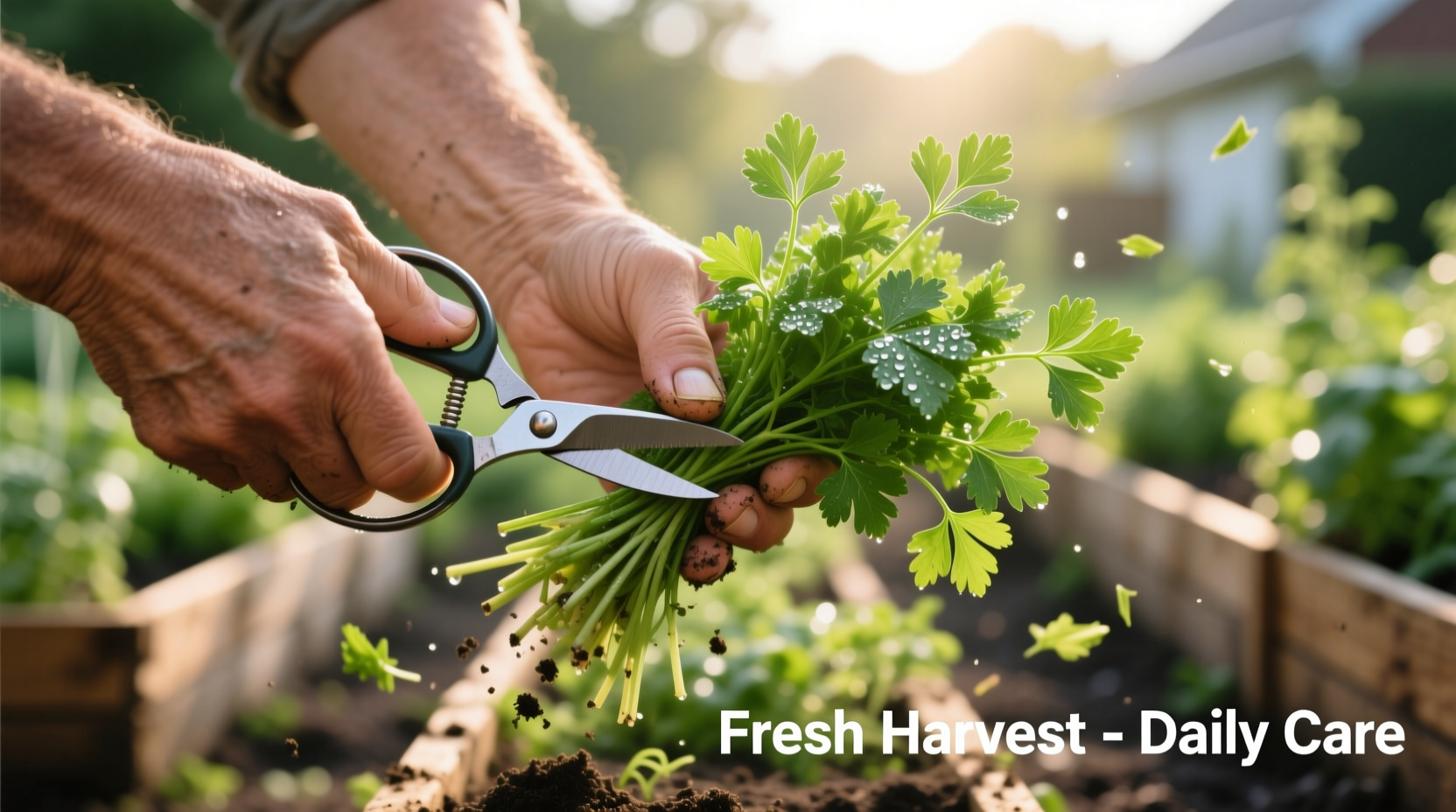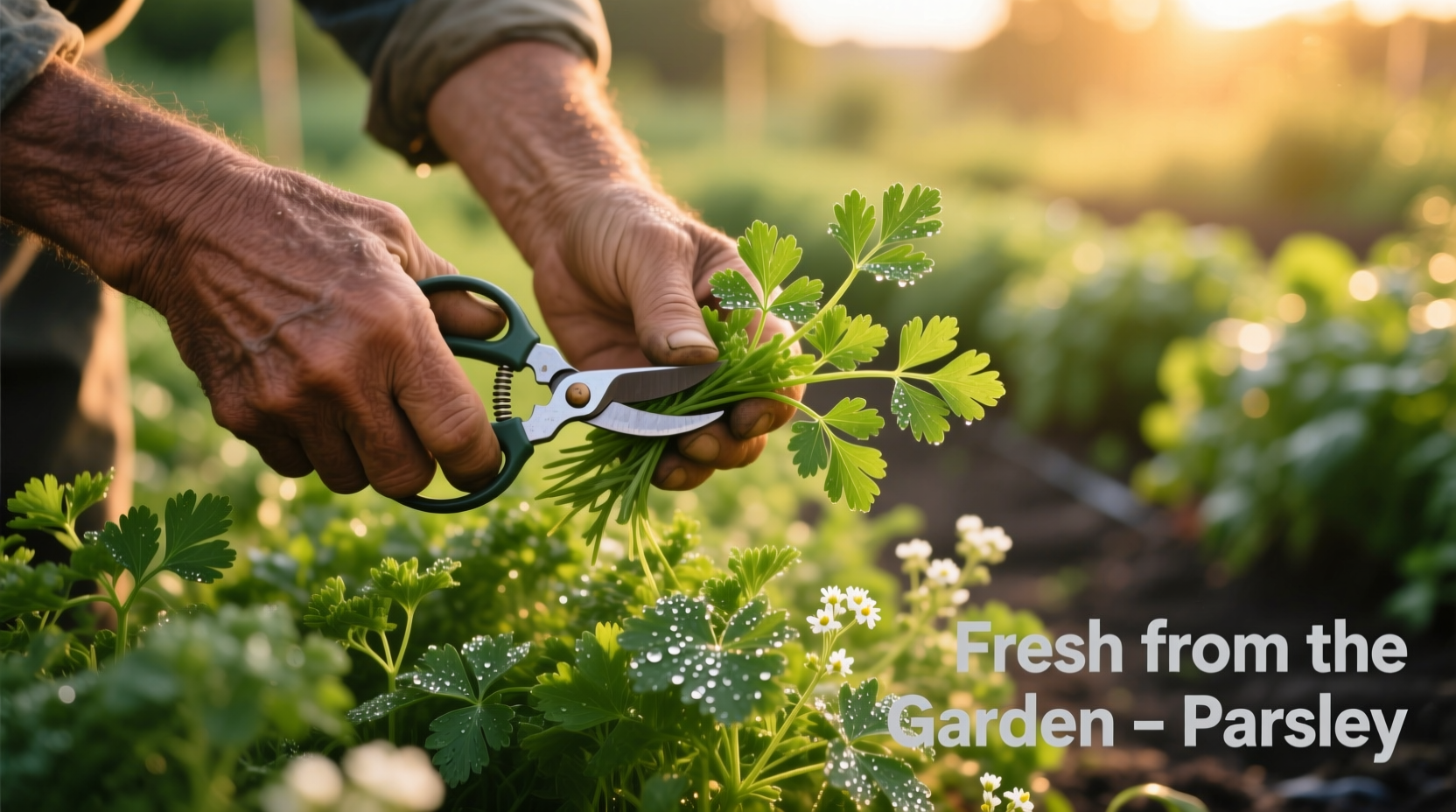Harvesting parsley correctly transforms your garden yield from sparse sprigs to abundant, flavorful harvests that keep coming season after season. Whether you're growing flat-leaf Italian or curly varieties, mastering the harvest technique means enjoying fresh parsley for cooking, garnishing, and preserving without sacrificing plant health.
When Your Parsley Is Ready for Harvest
Parsley reaches harvest readiness approximately 70-90 days after planting, depending on variety and growing conditions. The critical indicators that your parsley is ready include:
- Stem length - Outer stems should measure 6-8 inches from soil line
- Leaf development - Three distinct leaf segments visible on each stem
- Color intensity - Deep, vibrant green without yellowing
- Plant maturity - At least 10-12 leaves total on the plant
The optimal time of day for harvesting parsley is early morning, after the dew has dried but before temperatures rise significantly. According to research from the University of California Cooperative Extension, essential oil concentration peaks during this window, delivering maximum flavor and aroma. Avoid harvesting during midday heat or immediately after watering, as this dilutes flavor compounds and increases wilting risk.
| Harvest Timing Factor | Optimal Condition | Suboptimal Condition |
|---|---|---|
| Time of Day | Early morning (8-10 AM) | Midday or afternoon |
| Weather Conditions | Dry day after 24 hours without rain | During or immediately after rain |
| Plant Hydration | Slightly moist soil | Overwatered or drought-stressed |
| Seasonal Timing | Before flowering (bolting) | After flowering begins |
The Correct Harvesting Technique
Proper harvesting technique directly impacts your parsley plant's longevity and future yield. Follow these steps for optimal results:
- Identify mature outer stems - Focus on the largest, outermost stems which are typically the most mature
- Locate the harvest point - Find where the stem meets the main crown, approximately 1-2 inches above soil level
- Use sharp scissors or pruners - Clean, sharp tools make precise cuts that heal quickly
- Cut at a 45-degree angle - This angle promotes water runoff and reduces disease risk
- Limited harvest amount - Never remove more than one-third of the plant's total foliage at once

This selective harvesting method encourages new growth from the plant's center while maintaining enough foliage for photosynthesis. The Royal Horticultural Society confirms that plants harvested using this technique typically produce 30-50% more total yield over a growing season compared to improper harvesting methods.
Post-Harvest Handling for Maximum Freshness
What you do immediately after harvesting determines how long your parsley stays fresh and flavorful:
- Cleaning process - Rinse gently in cool water, then spin dry in a salad spinner or pat dry with clean towels
- Short-term storage - Place stems in a glass with 1 inch of water, cover loosely with plastic bag, refrigerate (lasts 1-2 weeks)
- Long-term preservation - Freeze in ice cube trays with water or olive oil, or dry using a food dehydrator at 95°F
Research from the USDA Agricultural Research Service shows that parsley stored in water maintains 85% of its vitamin C content for 10 days, while air-dried storage preserves essential oils better for culinary applications requiring intense flavor.
Maximizing Future Harvests Through Proper Care
Your harvesting technique directly affects future yields. Implement these practices after each harvest:
- Watering schedule - Water deeply the day after harvesting to encourage new growth
- Fertilization - Apply balanced organic fertilizer (5-5-5) every 4-6 weeks during growing season
- Pruning strategy - Remove any yellowing leaves to redirect energy to healthy growth
- Flower management - Pinch off flower buds immediately to prevent bolting and maintain leaf production
Parsley grown as a biennial typically provides the most abundant harvests during its second growing season. The Cornell University Gardeners' Handbook notes that properly maintained plants can yield harvests for 18-24 months in temperate climates before declining in productivity.
Troubleshooting Common Harvesting Issues
Even experienced gardeners encounter challenges when harvesting parsley. Here's how to address common problems:
- Slow regrowth after harvest - Ensure you're not removing too much foliage at once; verify adequate sunlight (minimum 6 hours daily)
- Yellowing leaves post-harvest - Often indicates overwatering; allow soil to dry slightly between waterings
- Bitter tasting leaves - Usually occurs when harvesting during hot afternoon hours; switch to morning harvests
- Thin, spindly growth - Sign of insufficient light or nutrients; relocate to sunnier spot or apply balanced fertilizer
Understanding these context boundaries helps tailor your harvesting approach to specific growing conditions. For container-grown parsley, harvest slightly less frequently than garden-planted varieties, as potted plants have more limited root systems and nutrient access.
Seasonal Harvesting Considerations
Parsley harvesting requires different approaches throughout the growing season:
- Spring harvests - Focus on establishing strong growth; take only small amounts initially
- Summer harvests - Increase frequency but remain mindful of heat stress; harvest early morning
- Fall harvests - Take larger harvests before first frost; consider bringing plants indoors
- Winter harvesting - In mild climates, continue harvesting but reduce frequency; protect from frost
According to data from the National Gardening Association, gardeners who adjust their harvesting technique seasonally report 40% higher satisfaction with their parsley yields compared to those using a consistent approach year-round.
Frequently Asked Questions
How often can I harvest parsley from the same plant?
You can harvest parsley every 2-3 weeks during peak growing season, provided you follow the one-third rule (never removing more than one-third of the plant's foliage at once). In optimal conditions, this allows for 8-12 harvests per growing season without stressing the plant.
Should I harvest parsley before or after it flowers?
Always harvest parsley before it flowers (bolts). Once flowering begins, leaf production slows significantly and flavor becomes more bitter. If your plant starts flowering, harvest immediately and consider replacing the plant, as post-flowering parsley rarely returns to productive leaf growth.
Can I harvest parsley in winter?
Yes, in USDA hardiness zones 6 and warmer, parsley often survives winter and can be harvested during mild spells. In colder zones, bring plants indoors before first frost for continued winter harvesting. Container-grown parsley typically yields better winter harvests than garden-planted varieties.
What's the best way to harvest parsley for drying?
For drying, harvest parsley in mid-morning after dew dries but before heat intensifies, when essential oil concentration peaks. Take larger stems with more mature leaves, as they contain higher concentrations of flavor compounds that preserve well through the drying process. Avoid washing before drying to prevent moisture retention issues.
How do I know if I've harvested too much parsley?
Signs of over-harvesting include significantly slowed regrowth, yellowing of remaining leaves, and thin, spindly new growth. If you notice these symptoms, stop harvesting completely for 4-6 weeks to allow the plant to recover. In severe cases, the plant may not recover and need replacement.











 浙公网安备
33010002000092号
浙公网安备
33010002000092号 浙B2-20120091-4
浙B2-20120091-4